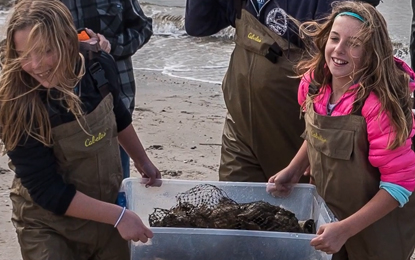Pacific Northwest Project Resources:

The Pacific Northwest region includes Oregon, Washington, and Idaho. With more than 4,430 miles of shoreline, 20 national forests, and the vast Cascade Mountain Range, this region has diverse topography, abundant natural resources, and varying climates.
The land west of the Cascade mountains has mild year-round temperatures, wet winters, and dry summers. East of the mountains, it is typically sunnier and drier throughout the year, with colder and much hotter summers.
The Pacific Northwest is one of the most ecologically intact regions in the contiguous United States. Once dominated by the timber industry, the region has shifted away from logging. More than 15 mills have closed in the past decade.


Volunteers helping plant sea grass as part of marsh restoration
Wildlife and fish in the region face multiple threats.
Increased population surrounding the major cities of Seattle and Portland has led to more pavement, less forest land, and more polluted runoff entering streams and rivers.
Iconic salmon and steelhead species continue to decline due to loss of habitat, polluted waters, overfishing, and hydropower dams that permanently block their historic upstream habitats.
Climate change has already led to many changes in the region, and more changes are expected in the future. These include:


Stabilizing shorelines and marshes using soft shoreline stabilization techniques will reduce erosion, improving habitat for fish that use shoreline areas for food and shelter. One study suggested that marshes protect shorelines from erosion better than bulkheads.
Local governments have taken steps to restrict development near vulnerable coastlines, streams, and rivers, and to require or encourage planted buffers. This should have positive impacts on salmon and other fish and wildlife.
Improving fish passage and access to spawning habitats will help threatened species of salmon and steelhead. After two dams were removed on the Elwha River in Puget Sound, Chinook salmon have spawned as far as 36 miles upriver.

Rain gardens capture and filter stormwater and slow the rate of runoff. An effort is underway to plant 12,000 rain gardens in the Puget Sound area.
Trees reduce runoff by breaking rainfall, and they help prevent stormwater from carrying pollutants into nearby waters. When trees are combined with other natural landscaping, as much as 65% of storm runoff can be reduced in residential areas.
Permeable pavement allows rainwater to pass through it into the ground below. Studies show that multiple types of permeable (or pervious) pavement substantially reduce the volume of runoff. They can also reduce pollutants, including heavy metals, motor oil, sediment, and some nutrients.
As snow melts earlier in spring, steps will need to be taken to conserve snowmelt water. The water is needed in summer for agriculture, fish and wildlife, drinking water, and recreation.


Permeable pavers in a neighborhood can help reduce runoff as well as reduce pollutants, including heavy metals, motor oil, and sediment.
We need your help to improve the Toolkit by completing our easy, 3-minute survey. Your insight is valuable to us.